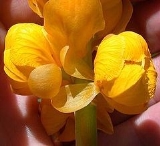
Senna alata
Encyclopedia

Flowering plant
The flowering plants , also known as Angiospermae or Magnoliophyta, are the most diverse group of land plants. Angiosperms are seed-producing plants like the gymnosperms and can be distinguished from the gymnosperms by a series of synapomorphies...
s in the subfamily Caesalpinioideae
Caesalpinioideae
Caesalpinioideae is a botanical name at the rank of subfamily, placed in the large family Fabaceae or Leguminosae. Its name is formed from the generic name Caesalpinia....
. It also known as a Candelabra Bush, Empress Candle Plant, Ringworm Tree or "candletree". A remarkable species
Species
In biology, a species is one of the basic units of biological classification and a taxonomic rank. A species is often defined as a group of organisms capable of interbreeding and producing fertile offspring. While in many cases this definition is adequate, more precise or differing measures are...
of Senna
Senna (genus)
Senna , the sennas, is a large genus of flowering plants in the family Fabaceae, subfamily Caesalpinioideae. This diverse genus is native throughout the tropics, with a small number of species reaching into temperate regions. The number of species is usually estimated to be about 260, but some...
, it was sometimes separated in its own genus
Genus
In biology, a genus is a low-level taxonomic rank used in the biological classification of living and fossil organisms, which is an example of definition by genus and differentia...
, Herpetica
Senna alata is native to Mexico
Mexico
The United Mexican States , commonly known as Mexico , is a federal constitutional republic in North America. It is bordered on the north by the United States; on the south and west by the Pacific Ocean; on the southeast by Guatemala, Belize, and the Caribbean Sea; and on the east by the Gulf of...
, and can be found in diverse habitats. In the tropics it grows up to an altitude of 1,200 meters. It is an invasive species
Invasive species
"Invasive species", or invasive exotics, is a nomenclature term and categorization phrase used for flora and fauna, and for specific restoration-preservation processes in native habitats, with several definitions....
in Austronesia
Austronesia
Austronesia, in historical terms, refers to the homeland of the peoples who speak Austronesian languages, including Malay, Filipino, Indonesian, Maori, Malagasy, native Hawaiian, the Fijian language and around a thousand other languages...
.
The shrub stands 3–4 m tall, with leaves 50–80 cm long. The inflorescence looks like a yellow candle. The fruit shaped like a straight pod is up to 25 cm long. Its seed are distributed by water or animals. The leaves close in the dark.
Medicinal uses
Cassia alata or Senna alata is often called the Ringworm Bush because of its very effective fungicidal properties, for treating ringworm and other fungal infections of the skin. The leaves are ground in a mortar to obtain a kind of "green cotton wool". This is mixed with the same amount of vegetable oil then rubbed on the affected area 2-3 times a day. A fresh preparation is made every day. Its active ingredients include the yellow chrysophanic acid.Its laxative effect, due to its anthraquinone
Anthraquinone
Anthraquinone, also called anthracenedione or dioxoanthracene is an aromatic organic compound with formula . Several isomers are possible, each of which can be viewed as a quinone derivative...
content, is also well proven.
Sources
- http://www.hear.org/pier/species/senna_alata.htm
- http://www.ildis.org/

